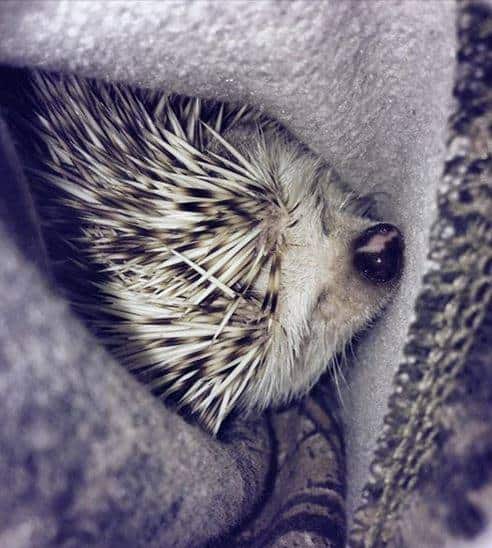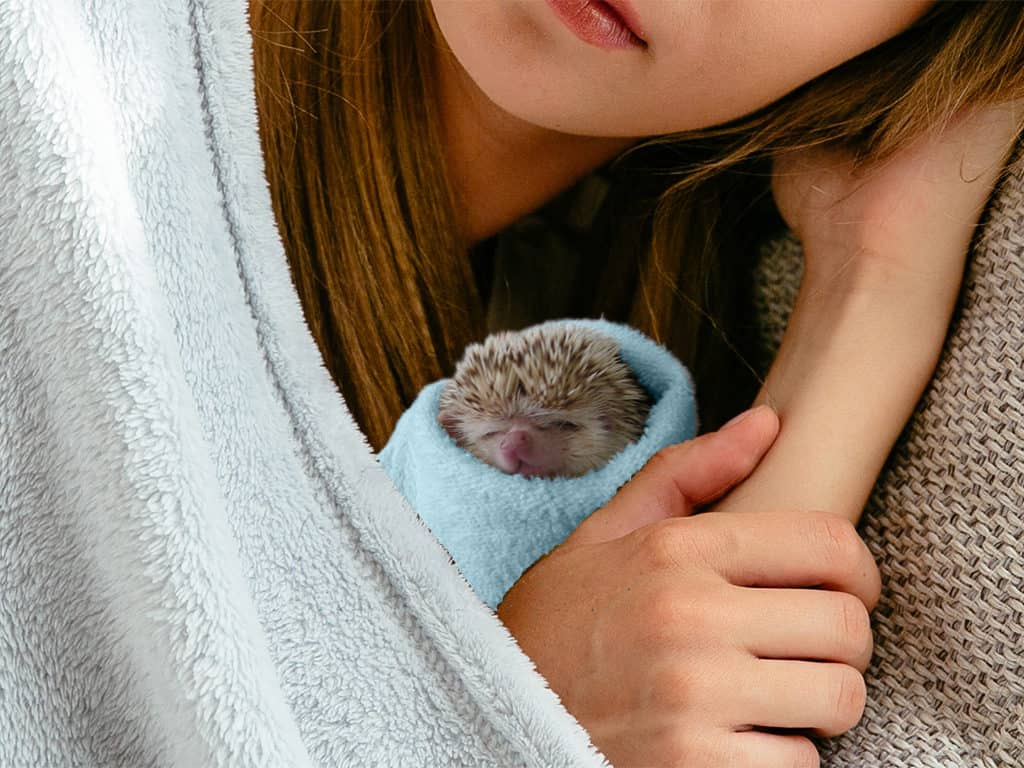Hedgehog hibernation can be life-threatening for a domesticated hedgie. Because African Pygmy hedgehogs are much smaller and have less fat reserves than their wild European cousins, they can be more sensitive to temperature fluctuations. By learning the signs and symptoms of a hedgehog hibernation attempt, you can potentially save their life.
In the wild, hedgehog hibernation is a useful survival instinct. When it's cold, there are less insects available to sustain them, so hibernation makes sense. Additionally, as the seasons change, so do the number of daylight hours. The longer hours of darkness can indicate that the seasons are changing. During hibernation, their heart rate, respiration, temperature and metabolic rate all decrease to a bare minimum to sustain life. And when they absolutely need to feed again, they successfully regain normal activity.
However, domesticated hedgehogs don't face the same scarcity of food. Nor do they typically experience the same drastic temperature fluctuations. They aren't adapted to this survival instinct. Therefore, when a pet hedgehog attempts to hibernate, it can quickly escalate into an emergency situation. The drastic decrease in their metabolic rate can compromise their immune system. In turn, this leaves them susceptible to other illnesses even if you are able to revive them out of hibernation.
Temperature Regulation
Like humans, hedgehogs can only regulate temperature on a limited basis. And even then, hedgies can only regulate within a certain limited range. As a result, pet hedgehogs truly rely on their humans to regulate temperature for them.
Temperature regulation within a hedgehog's habitat can be accomplished several different ways. That topic has been detailed in our article: The Best Hedgehog Cage Heater System. Please look it over if you're unsure of your current system or need suggestions.
Preventing a Hibernation Attempt
Since the number of hours of dark versus light can trigger a hibernation attempt, it makes sense to control this. Many hedgehog owners supplement natural lighting with LED lights that they cycle every 12-hours via a timer. LED lighting isn't the required source – just the most economical. This is an environmental factor that is easily controlled.
Heating is the trickier and more critical environmental factor that needs control. As humans, we enjoy a temperature-controlled home that is often cooler than a hedgehog's comfort zone. And, hedgehog hibernation attempts don't only occur during the winter. Because of this, there is a need for a consistent and regulated heat source year round to help prevent hibernation attempts.
One often overlooked source of temperature fluctuation is drafts. Even the most reliable cage heating system will struggle against a drafty environment. For that reason, you can help prevent hibernation attempts by shrouding the cage with an insulated blanket or draft block. Something as simple as a vinyl shower curtain can help keep the cage heat in and the cold drafts out. Make sure that they still have a source of ventilation!

Also, we live in a world where there are power outages at times. This occurs more frequently in some places than in others. So, imagine it's winter and the power goes out. How do you keep your hedgehog warm and prevent a hibernation attempt? There are only a few ways:
- An uninterruptible power supply sufficiently large enough to carry the electrical load for an hour or two
- A backup generator that can carry the electrical load
- Gas heat that doesn't require electricity (like gas log fireplaces)
- Body heat to replace the electrically powered heat system
- An alternate heated location until power is restored
Beginning Signs of a Hedgehog Hibernation Attempt
There are several signs that a hedgie is headed for hibernation. Unfortunately, several of those signs could be an indicator of a different problem altogether. Often, illnesses that share a common set of signs, become difficult to diagnose. For instance, there are some signs of a hibernation attempt that are also common to Wobbly Hedgehog Syndrome (WHS). If you'd like to learn more about WHS and other hedgehog illnesses, you can find an article about that here.
If your hedgehog is acting sluggish, lethargic, uncoordinated or they are wobbly with the inability to move limbs; it may be a hibernation attempt. Some hedgehog owners fear the worst – Wobbly Hedgehog Syndrome – which is a definite death sentence. Between the two, you can determine hedgehog hibernation quite easily.
Other signs of your hog possibly preparing for hibernation is a loss of appetite, diminished thirst, shivering, or curling up and unwilling to unball. It isn't necessary that your hedgehog exhibit ALL of these signs to clue you that intervention may be needed.
Symptoms of Hedgehog Hibernation
There are several symptoms when a hedgie successfully enters a hedgehog hibernation state. The most obvious visual cue is that they are curled into a tight ball that you cannot get them out of. Additionally, you will find that they are not hissing or popping when you pick them up.
Other symptoms of hibernation include a cold belly, substantially lowered heart rate (2-50 beats per minute), and breaths that come at distant intervals. If your pet hedgehog fully enters this hibernation state, we advise you to seek immediate medical attention. If you are simply unable to find an open veterinary clinic or animal hospital, follow the steps in the next section.
How to Stop Hedgehog Hibernation Attempts
If you think that your hedgehog may be hibernating or attempting to enter hibernation, you can easily intervene. The key to successful revival is for you to gradually increase their body temperature. To do that, body to body contact with your skin is the best way. Simply place them under your shirt and snuggle up under the blankets. Although their quills will be pokey, being jabbed is a small price to pay in order to revive them. If you must, you can use a very thin t-shirt as a barrier. It will take a little longer for your body heat to radiate through the t-shirt, but you can compensate with a heating pad over the top of a blanket barrier.
If your lap cactus is with a caretaker that is too afraid to put them under their shirt, have them raise the temperature of the habitat heating system a couple of degrees. Also, instruct them to put a heating pad set on low under the habitat beneath your hedgie – with a thick towel barrier to avoid burns. Most importantly, do not make any sudden temperature changes.
Don't panic if neither of these measures yield immediate results, because they won't! However, within an hour, you should see increasing activity and movement. As long as they are progressively improving, even in small increments, you are on the right track.
- Don't plunge your hedgehog into a warm bath (can cause thermal shock and trauma)
- Never use a heating pad set on high (risk of burn and thermal shock)
- Never aim a space heater directly at the cage (the draft from the fan can induce thermal shock)
When Should I Take My Hedgehog To the Vet After a Hibernation Attempt
Veterinary intervention is necessary if your hedgehog doesn't show progressive activity within an hour. If they are still unresponsive or minimally responsive and cold this is considered an emergency. Please seek immediate treatment from a veterinarian or animal hospital. Additionally, if your hedgehog has revived but is exhibiting abnormal behavior, you may want to seek veterinary care.
Another reason for a visit to the vet is for your peace of mind. We understand how these adorable and loving animals capture the hearts of their owners. Also, hedgehog hibernation can strike panic as your mind leaps to the fatal conclusion. If for no other reason than reassurance that your ouch mouse is alright, you may want to schedule a vet visit.
Because we know how expensive veterinary care can be, we partnered with a company that offers a 25% discount on all veterinary care without exclusion for pre-existing conditions. In order to benefit from the savings, you must be a member and use a participating veterinarian or animal hospital.
Steps To Take After A Hibernation Attempt
As your hedgehog is recovering from hibernation or an attempt at it, extra cuddles have been proven to have therapeutic value. It will do both of you some good. You'll need to keep an eye on your hedgie because once a hedgehog attempts to hibernate, they are prone to attempt it again.
You probably should re-evaluate their heating and lighting system. If you are able to increase the temperature by a couple of degrees, we recommend that you do it. However, if your heat system is already struggling to maintain temperature, you should increase the wattage of your CHE bulb. Or you can add supplemental heating, too. If you find that a component is faulty, you'll want to replace it. Your hog's vet may be able to make recommendations to help avoid future hedgehog hibernation events.
And finally, from a hedgehog's view point, extra wormies are warranted too! After all, any excuse is a good excuse for more bug treats!
AFFILIATE DISCLOSURE: Heavenly Hedgies is an Amazon Associate. We have partnered with them and other reputable merchants when they sell something that we feel will benefit our readers. By purchasing through our links, we may earn a small commission on sales, that helps us continue to provide informative and educational information for hedgie lovers. And the best part is that there is no additional cost to you. Thank you for being a loyal and supportive reader here at Heavenly Hedgies.





